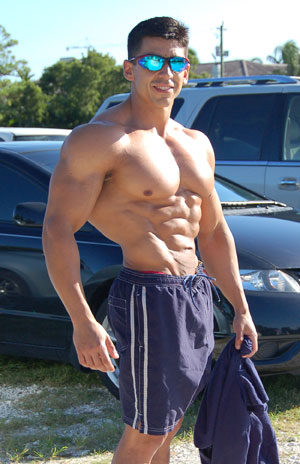No other muscle is more impressive and speaks more volumes about your fitness level than the ab muscles. Ab muscles in conjunction with a well developed and balanced physique put you in a whole different category when you take your shirt off at the beach. However, this muscle group is one of the most misunderstood ones in terms of how to train it and how to achieve that ripped midsection look.
In this article, I want to cover in detail what you need to do in order to achieve an impressive set of abs. First of all, I have to start by saying that everyone in this world is born with abs. Ask any student of college anatomy that has opened up a human body and analyzed what is inside. They will tell you that every human subject had abdominal muscles regardless of training. So if we all have abs, then how come we can’t see them? The reason for that is the wall of fat that is covering prevents the muscles from being visible. This leads to the first rule for getting abs:
PRINCIPLE #1:
In Order To Get Abs, You Need To Decrease Your Body Fat Percentage.
There are no “if’s” or “but’s” about this. Too much body fat and you won’t be able to see your abs. In order for men to start seeing some of their abs, they need to be at 10% or below. Women, on the other hands, start to see lines at 13% since women typically store body fat in other areas such as the hips and glutes.
In order to lower body fat, a good and balanced nutrition program consisting of 40% carbs, 40% proteins and 20% fats presents a good starting point in conjunction with some cardiovascular exercise and a good periodized weight training routine that exercises your whole body and includes abdominal work.
PRINCIPLE #2:
To have the best-looking abs, one needs to exercise them correctly and understand abdominal anatomy in addition to following principle #1.
This principle is pretty much self-explanatory and it leads us to the next topic, which is that of abdominal anatomy.
Abdominal Anatomy
There Are Four Main Muscle Groups That Make Up The Full Abdominal Wall:
• The Rectus Abdominis (composed of upper and lower abdominals)
• The Oblique Muscles
• The Intercostal Muscles
• The Serratus Anterior
Rectus Abdominis Function & Exercises
The muscle that extends from the top of the pelvis to the sternum is called the rectus abdominis. This is the primary abdominal muscle, which when properly developed (assuming that the person has low enough body fat levels), will give the illusion of a six-pack. Its function is to pull the upper torso towards the hips when the body is only slightly flexed at the waist. This is the reason why if you are doing a sit-up, any additional torso movement done past the initial 30 degrees from the floor will not stimulate the abs; instead, the hips will be the ones that will complete the movement. Because of this, partial sit-ups performed with the torso moving up to 30 degrees and crunches are great allies in our quest to achieve great abs.
However, if you really want to maximally stimulate the abdominals, prevent lower back problems and get the most “bang for your buck” so to speak, then you need to also consider the fact that the anatomy of the rectus abdominis is such that if you do not bend your torso backwards by around 15 to 20 degrees then you won’t be able to accomplish these things. Since the floor only provides a flat surface, not only your abs will not get maximal stimulation, but also they will not learn how to properly contract and protect your back when your body is bent backwards (as is often the case when advanced bodybuilders perform exercises like standing military presses).
The only way to get around this is by getting an exercise ball. An exercise ball is a great small investment (they run for about $8-$15 these days) as this apparatus will allow you to get the necessary backwards bend that your torso needs in order to maximally stimulate your abs.
So because of this, crunches performed on an exercise ball are the way in which I recommend you perform this exercise. Since the rectus abdominis also has muscles in the lower region that help maintain proper postural alignment, it becomes necessary to include reverse crunches performed on the swiss ball (make sure that you hold to a stationary sturdy object) as this exercise will allow you to go below the neutral (flat) position.
Another good lower abdominal exercise is the hanging leg raises. The key for maximal stimulation in this exercise is to roll the pelvis slightly backwards at the beginning of the movement.
Oblique Muscles Function & Exercises
The external obliques are the muscles at the sides of the waist. The external oblique complex actually consists of three layers of muscles: the internal obliques, the transverse obliques and external obliques. Together, these muscles contract to tilt the torso, as well as twist it, from side to side. While a bodybuilder would not want massive obliques as this would take away from symmetry and give the illusion of a thick waist, these muscles do need to be trained in order to maintain ideal postural alignment.
A great exercise for these muscles is the side bends performed on a swiss ball. Another exercise that also needs to be performed for these muscles in order to exercise its rotating capabilities are the Russian Twists.
The Intercostal Muscles
The intercostals are the muscles of breathing that lie between the ribs and show as bands of muscle angling downward in the sides of the rib cage and the upper abdomen. The intercostals come into play by flexing the torso and causing it to twist, so doing any type of twisting crunch on a swiss ball will stimulate this group maximally.
The Serratus Muscles
The serratus anterior muscles are the finger-like strands of muscle on the rib cage between the front abs and the lats. Their job is to depress the rib cage and also assist in bringing the upper arms from a position pointing directly up from the shoulders to one pointing directly below the shoulders. A good exercise that will stimulate these muscles is the one-arm cable crunches (using an overhead pulley).
PRINCIPLE #3:
Sets and Reps are dependent upon how advanced the person is.
Initially, ab training should just consist of a couple to three movements at the most, performed for 2-3 sets of as many good concentrated repetitions as the person can do with his/her bodyweight. As time goes by and one progresses, more sets can be added and repetition parameters can also be manipulated by adding weights to some exercises in order to target the fast twitch muscle fibers in the abs and thus create a six-pack with deeper grooves in between. Adding weight to abdominal exercises will not give you a bloated stomach look.
PRINCIPLE #4:
Unless you are training one-day upper abs and the next day lower abs (a very advanced technique), training abs every day will typically lead to overtraining them. While many advanced bodybuilders and figure girls can train their abs every day for a short period of time in order to shock the body part, this typically will lead to overtraining if continued for too long. Therefore, unless you are doing upper abdominals one day and lower the next, you are better off training your abdominals for no more than 20 minutes at a time, 3 times per week on alternating days, as in Mon/Wed/Fri.
PRINCIPLE #5:
As one gets more advanced, repetition tempo (the speed at which one performs the exercises) can also be altered in order to elicit a response.
One very neglected variable of training that never gets altered is that one of repetition speed. As one becomes more advanced, a set can always be made more challenging by altering the speed at which the positive portion of the movement is performed, the length of the contraction and the speed of the negative portion. Doing this will, in turn, stimulate more muscle fibers in the area which results in faster results!
PRINCIPLE #6:
Do not train the obliques with low repetitions.
Unless you want big sides and a wide waist, then oblique training with low reps should not be an option. High reps in the order of 25-50 are best. As a matter of fact, some people are so genetically gifted that their sides grow from little oblique work (this is true for me). In this case, oblique work should be completely taken out.
PRINCIPLE #7:
For a smaller waist, try training the TVA muscle as well.
The TVA, or traverse abdominus, is an abdominal muscle whose function is not to cause movement of the spine, but instead to keep the waist nicely tucked in. To train it, all you have to do is suck your stomach in. I’m serious; believe it or not, that is the purpose of that muscle. So by exhaling all of the air out of your lungs and bringing the navel as close as possible to your spine you will be training the TVA and thus creating the appearance of a smaller waist. Because of the nature of this muscle, it can be trained every day at any time. Three sets of 30-second contractions should get you started.
Please Let Us Know If You Enjoyed This Article.
Your Feedback Is Important To Us
Disclaimer: This content is for informational purposes only and is not meant as medical advice, nor is it to diagnose or treat any medical condition. Please consult your physician before starting or changing your diet or exercise program. Any use of this information is at the sole discretion and responsibility of the user.













